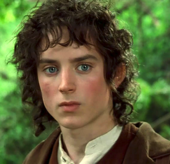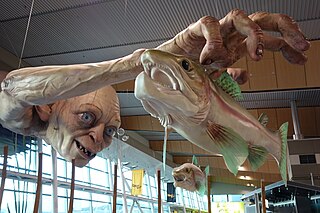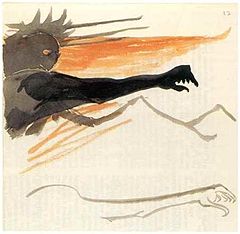Internal history

Background
Frodo is introduced in The Lord of the Rings as Bilbo Baggins's cousin [lower-alpha 1] and adoptive heir. [T 1] Frodo's parents Drogo Baggins and Primula Brandybuck had been killed in a boating accident when Frodo was twelve; Frodo spent the next nine years living with his maternal family, the Brandybucks in Brandy Hall. At the age of twenty-one he was adopted by Bilbo, who brought him to live at his home, Bag End. He and Bilbo shared the same birthday, the 22nd of September. Bilbo introduced Frodo to the Elvish languages, and they often went on long walking trips together. [T 1]
The Fellowship of the Ring
Frodo came of age as Bilbo left the Shire. Frodo inherited Bag End and Bilbo's ring. Gandalf, uncertain about the origin of the ring, warned Frodo to avoid using it and to keep it secret. [T 1] Frodo kept it hidden for the next seventeen years, and it gave him the same longevity it had given Bilbo. Gandalf returned to tell him that it was the One Ring of the Dark Lord Sauron, who was seeking to recover and use it to conquer Middle-earth. [T 2]
Realizing that he was a danger to the Shire as long as he remained there, Frodo decided to take the Ring to Rivendell, home of Elrond, a mighty Elf-lord. He left with three companions: his gardener Samwise Gamgee and his cousins Merry Brandybuck and Pippin Took. They were just in time, for Sauron's most powerful servants, the Nine Nazgûl, had entered the Shire as Black Riders, looking for the Ring. They followed Frodo's trail, nearly intercepting him. [T 3] [T 4] [T 5]
The hobbits escaped into the Old Forest. They were waylaid by the magic of Old Man Willow, but rescued by Tom Bombadil, [T 6] who gave them shelter and guidance. [T 7] They were caught in fog on the Barrow Downs by a barrow-wight and put under a spell. Frodo broke free, attacked the barrow-wight and summoned Bombadil, who again rescued the hobbits and set them on their way. [T 8]
At the Prancing Pony inn, Frodo received a delayed letter from Gandalf, and met a man calling himself Strider, a Ranger; his real name was Aragorn. The One Ring slipped onto Frodo's finger in the inn's common room, turning him invisible. This attracted the Nazgûl, who ransacked the hobbits' empty rooms in the night. [T 9] Strider led the group through the marshes. [T 10]
While encamped on Weathertop, they were attacked by five Nazgûl. The leader, the Witch-king of Angmar, stabbed Frodo with a Morgul-blade, the wound threatening to turn him into a wraith under the Nazgûl's control. [T 11] Reaching Rivendell, [T 12] he was healed by Elrond. [T 13]
The Council of Elrond resolved to destroy the Ring by casting it into Mount Doom in Mordor, Sauron's realm. Frodo, realizing that he was destined for this task, stepped forward to be the Ring-bearer. A Fellowship of nine companions was formed to assist him: the hobbits, Gandalf, Aragorn, the dwarf Gimli, the elf Legolas, and Boromir, a man of Gondor. Bilbo, living in Rivendell, gave Frodo his sword Sting and a coat of Dwarf mail made of mithril . [T 14] The company, unable to cross the Misty Mountains by a pass, entered the mines of Moria. [T 15] Frodo was stabbed by an Orc with a spear, but his mithril mail-shirt saved his life. [T 16] Gandalf was killed battling a Balrog. [T 17] Aragorn led them out to Lothlórien. [T 18] There Galadriel gave Frodo an Elven cloak and a phial, which carries the Light of Eärendil to aid him on his quest. [T 19]
The Fellowship travelled by boat down the Anduin River and reach the lawn of Parth Galen, just above the impassable falls of Rauros. [T 20] There, Boromir, succumbing to the lure of the Ring, tried to take it by force. Frodo escaped by putting it on. This broke the Fellowship; the company was scattered by invading Orcs. Frodo chose to continue the quest alone, but Sam followed him. [T 21]
The Two Towers
Frodo and Sam made their way through the wilds, followed by the monster Gollum, who had been tracking them, seeking to reclaim the Ring, which he had lost to Bilbo (as portrayed in The Hobbit ). Gollum attacked the hobbits, but Frodo subdued him with Sting. He took pity on Gollum and spared his life, making him promise to guide them through the dead marshes to the Black Gate. [T 22] [T 23] They found the gate impassable; Gollum told them of "another way" into Mordor, [T 24] and Frodo, over Sam's objections, let him lead them south into Ithilien. [T 25] There they met Faramir, younger brother of Boromir, who took them to a hidden cave. [T 26] Frodo allowed Gollum to be captured by Faramir, saving Gollum's life but leaving him feeling betrayed. Faramir provisioned the hobbits and sent them on their way, warning Frodo to beware of Gollum's treachery. [T 27] [T 28]
They passed Minas Morgul, where the pull of the Ring became overwhelming, and climbed the Endless Stair to cross into Mordor. [T 29] At the top they entered a tunnel, not knowing it was the home of the giant spider Shelob. Gollum hoped to deliver the hobbits to her and retake the Ring after she had killed them. Shelob stung Frodo, rendering him unconscious, but Sam drove her off with Sting and the Phial of Galadriel. [T 30] Believing that Frodo was dead, Sam took the Ring and continued the quest. Soon, however, he overheard Orcs taking Frodo for questioning, saying that he was still alive. [T 31]
The Return of the King
Sam rescued Frodo and returned the Ring. [T 32] Dressed in scavenged Orc-armour, they set off, trailed by Gollum. [T 33] At Mount Doom, Frodo entered the chasm where Sauron had forged the Ring. Here Frodo lost the will to destroy the Ring, and put it on, claiming it for himself. Gollum attacked the invisible Frodo, biting off his finger and reclaiming the Ring. As he danced in elation, Gollum fell with the Ring into the fiery Cracks of Doom. The Ring was destroyed, and with it Sauron's power. Frodo and Sam were rescued by Great Eagles as Mount Doom erupted, destroying Mordor. [T 34]
After Aragorn's coronation, the four hobbits returned home. [T 35] They found that the fallen wizard Saruman and his agents had taken over the Shire and started to industrialize it. Frodo and his companions led a rebellion and defeated the intruders. Even after Saruman attempted to stab Frodo, Frodo let him go, only for Saruman to be killed by his henchman Gríma Wormtongue. [T 36] The hobbits restored the Shire to its prior state of peace and goodwill. While successful in his quest, Frodo never recovered from the physical and emotional wounds he suffered on the quest. After two years, Frodo and Bilbo as Ring-bearers were granted passage to Valinor. [T 37]
Other works
"The Sea-Bell" was published in Tolkien's 1962 collection of verse The Adventures of Tom Bombadil with the sub-title Frodos Dreme. Tolkien suggests that this enigmatic narrative poem represents the despairing dreams that visited Frodo in the Shire in the years following the destruction of the Ring. It relates the unnamed speaker's journey to a mysterious land across the sea, where he tries but fails to make contact with the people who dwell there. He descends into despair and near-madness, eventually returning to his own country, to find himself utterly alienated from those he once knew. [2]
"Frodo the halfling" is mentioned briefly at the end of The Silmarillion , as "alone with his servant he passed through peril and darkness" and "cast the Great Ring of Power" into the fire. [T 38]
In the poem Bilbo's Last Song , Frodo is at the Grey Havens at the farthest west of Middle-earth, about to leave the mortal world on an elven-ship to Valinor. [3]
"The Hunt for the Ring" in Unfinished Tales describes how the Black Riders travelled to Isengard and the Shire in search of the One Ring, purportedly "according to the account that Gandalf gave to Frodo". [lower-alpha 2] It is one of several mentions of Frodo in the book. [T 39]
Family tree
The Tolkien scholar Jason Fisher notes that Tolkien stated that hobbits were extremely "clannish" and had a strong "predilections for genealogy". [4] Accordingly, Tolkien's decision to include Frodo's family tree in Lord of the Rings gives the book, in Fisher's view, a strongly "hobbitish perspective". [4] The tree also, he notes, serves to show Frodo's and Bilbo's connections and familial characteristics. [4] Frodo's family tree is as follows: [T 40]
| Baggins family tree [T 40] | |||||||||||||||||||||||||||||||||||||||||||||||||||||||||||||||||||||||||||||||||||||||||||||||||||||||||||||||||||||||||||||||||||||||||||||||||||||||||||||||||||||||||||||||||||||||||||||||||||||||||||||||||||||||||||||||||||||||||||||||||||||||||||||||||||||||||||||||||||||||||||||||||||||||||||||||||||||||||||||||||||||||||||||||||||||||||||||||||||||||||||||||||||||||||||||||||||||||||||||||||||||||||||||||||||||||||||||||||||||||||||||||||||||||||||||||||||||||||||||||||||||||||||||||||||||||||||||||||||||||||||||||||||||||||||||||||||||||||||||||||||||||||||||||||||||||||||||||||||||||||||||||||||||||||||||||||||||||||||||||||||||||||||||||||||||||||||||||||||||||||||||||||||||||||||||||||||||||||||||||||||||||||||||||||||||||||||||||||||||||||||||||||||||||||||||||||||||||||||||||||||||||||||||||||||||||||||||||||||||||||||||||||||||||||||||||||||||||||||||||||||||||||||||||||||||||||||||||||||||||||||||||||||||||||||||||||||||||||||||||||||||||||||||||||||||||||||||||||||||||
|---|---|---|---|---|---|---|---|---|---|---|---|---|---|---|---|---|---|---|---|---|---|---|---|---|---|---|---|---|---|---|---|---|---|---|---|---|---|---|---|---|---|---|---|---|---|---|---|---|---|---|---|---|---|---|---|---|---|---|---|---|---|---|---|---|---|---|---|---|---|---|---|---|---|---|---|---|---|---|---|---|---|---|---|---|---|---|---|---|---|---|---|---|---|---|---|---|---|---|---|---|---|---|---|---|---|---|---|---|---|---|---|---|---|---|---|---|---|---|---|---|---|---|---|---|---|---|---|---|---|---|---|---|---|---|---|---|---|---|---|---|---|---|---|---|---|---|---|---|---|---|---|---|---|---|---|---|---|---|---|---|---|---|---|---|---|---|---|---|---|---|---|---|---|---|---|---|---|---|---|---|---|---|---|---|---|---|---|---|---|---|---|---|---|---|---|---|---|---|---|---|---|---|---|---|---|---|---|---|---|---|---|---|---|---|---|---|---|---|---|---|---|---|---|---|---|---|---|---|---|---|---|---|---|---|---|---|---|---|---|---|---|---|---|---|---|---|---|---|---|---|---|---|---|---|---|---|---|---|---|---|---|---|---|---|---|---|---|---|---|---|---|---|---|---|---|---|---|---|---|---|---|---|---|---|---|---|---|---|---|---|---|---|---|---|---|---|---|---|---|---|---|---|---|---|---|---|---|---|---|---|---|---|---|---|---|---|---|---|---|---|---|---|---|---|---|---|---|---|---|---|---|---|---|---|---|---|---|---|---|---|---|---|---|---|---|---|---|---|---|---|---|---|---|---|---|---|---|---|---|---|---|---|---|---|---|---|---|---|---|---|---|---|---|---|---|---|---|---|---|---|---|---|---|---|---|---|---|---|---|---|---|---|---|---|---|---|---|---|---|---|---|---|---|---|---|---|---|---|---|---|---|---|---|---|---|---|---|---|---|---|---|---|---|---|---|---|---|---|---|---|---|---|---|---|---|---|---|---|---|---|---|---|---|---|---|---|---|---|---|---|---|---|---|---|---|---|---|---|---|---|---|---|---|---|---|---|---|---|---|---|---|---|---|---|---|---|---|---|---|---|---|---|---|---|---|---|---|---|---|---|---|---|---|---|---|---|---|---|---|---|---|---|---|---|---|---|---|---|---|---|---|---|---|---|---|---|---|---|---|---|---|---|---|---|---|---|---|---|---|---|---|---|---|---|---|---|---|---|---|---|---|---|---|---|---|---|---|---|---|---|---|---|---|---|---|---|---|---|---|---|---|---|---|---|---|---|---|---|---|---|---|---|---|---|---|---|---|---|---|---|---|---|---|---|---|---|---|---|---|---|---|---|---|---|---|---|---|---|---|---|---|---|---|---|---|---|---|---|---|---|---|---|---|---|---|---|---|---|---|---|---|---|---|---|---|---|---|---|---|---|---|---|---|---|---|---|---|---|---|---|---|---|---|---|---|---|---|---|---|---|---|---|---|---|---|---|---|---|---|---|---|---|---|---|---|---|---|---|---|---|---|---|---|---|---|---|---|---|---|---|---|---|---|---|---|---|---|---|---|---|---|---|---|---|---|---|---|---|---|---|---|---|---|---|---|---|---|---|---|---|---|---|---|---|---|---|---|---|---|---|---|---|---|---|---|---|---|---|---|---|---|---|---|---|---|---|---|---|---|---|---|---|---|---|---|---|---|---|---|---|---|---|---|---|---|---|---|---|---|---|---|---|---|---|---|---|---|---|---|---|---|---|---|---|---|---|---|---|---|---|---|---|---|---|---|---|---|---|---|---|---|---|---|---|---|---|---|---|---|---|---|---|---|---|---|---|---|---|---|---|---|---|---|---|---|---|---|---|---|---|---|---|---|---|---|---|---|---|---|---|---|---|---|---|---|---|---|---|---|---|---|---|---|---|---|---|---|---|---|---|---|---|---|---|---|---|---|---|---|---|---|---|---|---|---|---|---|---|---|---|---|---|---|---|---|---|---|---|---|---|---|---|---|---|---|---|---|---|---|---|---|---|---|---|---|---|---|---|---|---|---|---|---|---|---|---|---|---|---|---|---|---|---|---|---|---|---|---|---|---|---|---|---|---|---|---|---|---|---|---|---|---|---|---|---|---|---|---|---|---|---|---|---|---|---|---|---|---|---|---|---|---|---|---|---|---|---|---|---|---|---|---|---|---|---|---|---|---|---|---|---|---|---|---|---|---|---|---|---|---|---|---|---|---|---|---|---|---|---|---|---|---|---|---|---|---|---|---|---|
| |||||||||||||||||||||||||||||||||||||||||||||||||||||||||||||||||||||||||||||||||||||||||||||||||||||||||||||||||||||||||||||||||||||||||||||||||||||||||||||||||||||||||||||||||||||||||||||||||||||||||||||||||||||||||||||||||||||||||||||||||||||||||||||||||||||||||||||||||||||||||||||||||||||||||||||||||||||||||||||||||||||||||||||||||||||||||||||||||||||||||||||||||||||||||||||||||||||||||||||||||||||||||||||||||||||||||||||||||||||||||||||||||||||||||||||||||||||||||||||||||||||||||||||||||||||||||||||||||||||||||||||||||||||||||||||||||||||||||||||||||||||||||||||||||||||||||||||||||||||||||||||||||||||||||||||||||||||||||||||||||||||||||||||||||||||||||||||||||||||||||||||||||||||||||||||||||||||||||||||||||||||||||||||||||||||||||||||||||||||||||||||||||||||||||||||||||||||||||||||||||||||||||||||||||||||||||||||||||||||||||||||||||||||||||||||||||||||||||||||||||||||||||||||||||||||||||||||||||||||||||||||||||||||||||||||||||||||||||||||||||||||||||||||||||||||||||||||||||||||||










